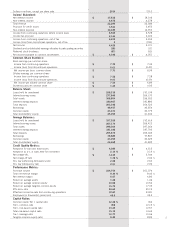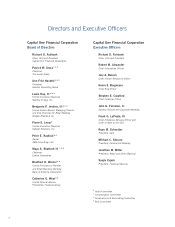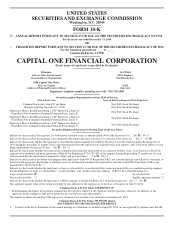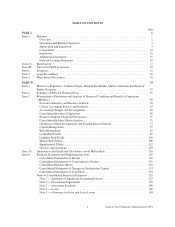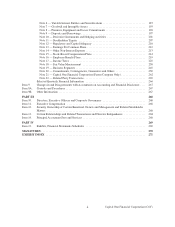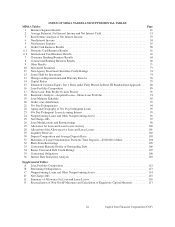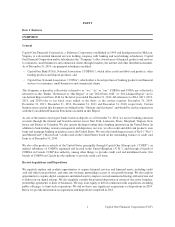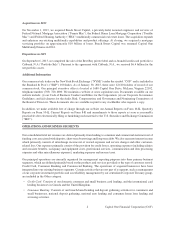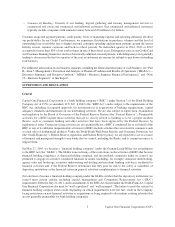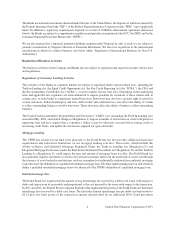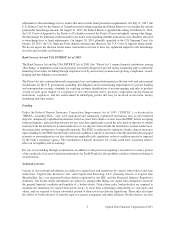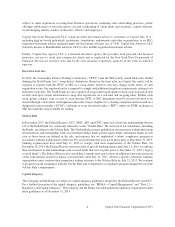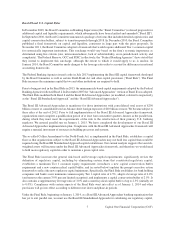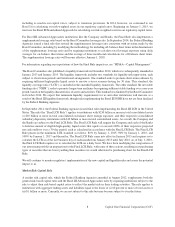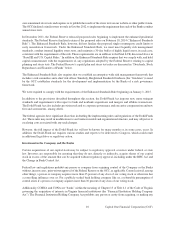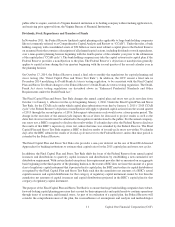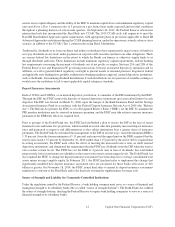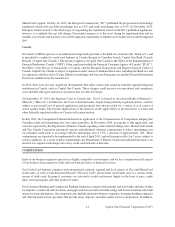Capital One 2014 Annual Report Download - page 27
Download and view the complete annual report
Please find page 27 of the 2014 Capital One annual report below. You can navigate through the pages in the report by either clicking on the pages listed below, or by using the keyword search tool below to find specific information within the annual report.adjustment to the interchange fee for issuers that meet certain fraud prevention requirements. On July 31, 2013, the
U.S. District Court for the District of Columbia issued a ruling requiring the Federal Reserve to reconsider the current
permissible interchange amount. On August 21, 2013, the Federal Reserve appealed this ruling. On March 21, 2014,
the U.S. Court of Appeals for the District of Columbia reversed the District Court and upheld, among other things,
the interchange fee limitation (with remand for one minor issue regarding whether transaction costs should be allocated
to interchange fees or fraud adjustments). On August 18, 2014, plaintiffs appealed to the U.S. Supreme Court. On
January 20, 2015, the U.S. Supreme Court denied certoriari and, therefore, the U.S. Court of Appeals ruling stands.
We do not expect the decision on the minor transaction cost issue to have any significant impacts to the interchange
fee rules and our debit card business.
Bank Secrecy Act and USA PATRIOT Act of 2001
The Bank Secrecy Act and the USA PATRIOT Act of 2001 (the “Patriot Act”) require financial institutions, among
other things, to implement a risk-based program reasonably designed to prevent money laundering and to combat the
financing of terrorism, including through suspicious activity and currency transaction reporting, compliance, record-
keeping and due diligence on customers.
The Patriot Act also contains financial transparency laws and enhanced information collection tools and enforcement
mechanisms for the U.S. government, including: due diligence and record-keeping requirements for private banking
and correspondent accounts; standards for verifying customer identification at account opening; and rules to produce
certain records upon request of a regulator or law enforcement and to promote cooperation among financial
institutions, regulators, and law enforcement in identifying parties that may be involved in terrorism, money
laundering and other crimes.
Funding
Under the Federal Deposit Insurance Corporation Improvement Act of 1991 (“FDICIA”), as discussed in
“MD&A—Liquidity Risk,” only well-capitalized and adequately-capitalized institutions may accept brokered
deposits. Adequately-capitalized institutions, however, must first obtain a waiver from the FDIC before accepting
brokered deposits, and such deposits may not pay rates that significantly exceed the rates paid on deposits of similar
maturity from the institution’s normal market area or, for deposits from outside the institution’s normal market area,
the national rate on deposits of comparable maturity. The FDIC is authorized to terminate a bank’s deposit insurance
upon a finding by the FDIC that the bank’s financial condition is unsafe or unsound or that the institution has engaged
in unsafe or unsound practices or has violated any applicable rule, regulation, order or condition enacted or imposed
by the bank’s regulatory agency. The termination of deposit insurance for a bank could have a material adverse
effect on its liquidity and its earnings.
For any of our funding through securitization, in addition to the provision requiring a securitizer to retain a portion
of the credit risk of an asset-backed securitization, the Dodd-Frank Act also prohibits conflicts of interest relating to
securitizations.
Nonbank Activities
Certain of our nonbank subsidiaries are subject to supervision and regulation by various other federal and state
authorities. Capital One Securities, Inc. and Capital One Investing, LLC (formerly known as Capital One
Sharebuilder, Inc.) are registered broker-dealers regulated by the SEC and the Financial Industry Regulatory
Authority. Our broker-dealer subsidiaries are subject to, among other things, net capital rules designed to measure
the general financial condition and liquidity of a broker-dealer. Under these rules, broker-dealers are required to
maintain the minimum net capital deemed necessary to meet their continuing commitments to customers and
others, and are required to keep a substantial portion of their assets in relatively liquid form. These rules also limit
the ability of broker-dealers to transfer capital to parent companies and other affiliates. Broker-dealers are also
5Capital One Financial Corporation (COF)


